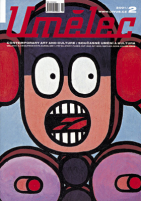| Revista Umělec 2001/2 >> Mori Finds Director | Lista de todas las ediciones | ||||||||||||
|
|||||||||||||
Mori Finds DirectorRevista Umělec 2001/201.02.2001 Vladan Šír | news | en cs |
|||||||||||||
|
The Japanese construction tycoon, Minoru Mori, cut a deal in May with Moderna Museet director David Elliot, who will become the head of the planned Mori Art Museum at the Mori Art Center in Tokyo. In six years Elliot was able to turn the Stockholm-based museum of modern art into one of Europe’s most respected institutions. (During his tenure, incidentally, the museum organized a major exhibition of Eas-tern European art, After the Wall, in which a number of young Czech artists participated.)
Minoru Mori intends to create a lar-ge complex of office and residential buildings, with a theater, a seat for Asahi TV and several hotels, in Rop-pongi, a central neighborhood of Tokyo. The Mori Art Center of which the Mori Art Muse-um is a part will occupy the top five floors of a 54-floor office high-rise in Roppongi Hills, as the complex is called. The total area of the museum exceeds 6,000 square meters. The top floors will house galleries boasting views over the city while lower floors will feature shops and conference halls. The new office space will represent a step up for Elliot, as the Center will be the first Japanese institution of the size of MoMA in New York, or the Centre Georges Pompidou in Paris. Moreover, the museum is a private entity and Elliot will be fully responsible for the exhibition program, including any accompanying events, and for the development of the art collection. The Museum will focus on modern and contemporary art, architecture and design. Elliot is set to cooperate closely with MoMA, and indeed, the opening exhibition will present art from the second half of the 20th century with reference to a similar exhibition recently on display at MoMA. Aside from the exhibitions, there are plans for the Mori Art Center to organize an international biennial of contemporary art, as well as residencies for artists and projects for public space. The Museum’s operations will be supervised by an international committee of advisors, including Glenn Lowry of MoMA, Wenzel Jacob, director of the Kunst- und Ausstel-lungs-halle in Bonn, Alfred Pacquement, director of the national museum of modern art in the Cen-tre Georges Pompidou, Norman Rosethal of the Royal Academy of Arts in London, Peter-Klaus Schus-ter of Staatliche Museen zu Berlin and Nicholas Serote, director of the Tate Museum in London. David Elliot’s successor will be appointed by the Swedish government. The Mori Art Center will open at the beginning of 2003. Vladan Šír
01.02.2001
Artículos recomendados
|
|||||||||||||





Comentarios
Actualmente no hay comentariosAgregar nuevo comentario